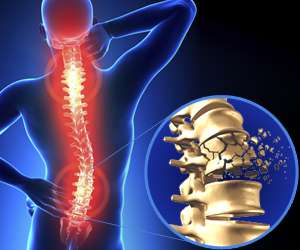Your spinal cord plays a significant role in every function of your body. And damage to the spinal cord results in a spinal cord injury, altering how your body functions. From weakness and changes in sensation to complete paralysis, spinal cord injuries have life-changing, lasting effects. Fortunately, science has made giant leaps and treatments like stem cell therapy show promising results.
Read on to learn the role of your spinal cord, how it becomes injured and how to begin recovering with the use of new regenerative medicines.
What does the spinal cord do?
Before we discuss the injury, let’s look at your spinal cord’s purpose.
Your spinal cord is a bundle of nerves that run from the brain down through the spine. The spinal cord and brain make up your central nervous system, controlling numerous functions, including movements, thoughts, memory and sensations. Sensory and motor nerves outside of the central nervous system create the peripheral nervous system, allowing other parts of the body to receive messages from the brain and spinal cord.
There’s one more set of nerves that control your involuntary functions. These are things your body does automatically, without any thought, such as digestion, temperature regulation and blood pressure. The control center of these functions is known as the parasympathetic nervous system and sympathetic nervous system.
As you can see, your nervous system sends commands to your body to perform every function. And your spinal cord is a significant participant, signaling other areas of your body to perform tasks that include voluntary muscle movements and sensory functions (touch, temperature, pain, etc.). It also controls bodily tasks we don’t even think twice about, such as breathing, heart rate and blood pressure.
Your body protects the spinal cord by layers of tissue (meninges) and by your spine, made up of vertebrae. But in some instances, the spinal cord, vertebrae or protective tissues become damaged, resulting in a spinal cord injury.
What is a spinal cord injury?
Spinal cord injuries occur when damage to the spinal cord results in temporary or permanent changes to functions controlled by the nervous system.
The adverse effects of spinal cord injuries vary by the severity of damage and cell death. Some injuries result in temporary changes, showing up as changes in sensations or numbness and tingling in your hands and feet. More severe cases result in permanent damage, like paralysis in some or most of your body.
How do spinal cord injuries happen?
The biggest cause of spinal cord injuries is trauma, such as automobile accidents. Spinal cord injuries generally result from sudden physical shock when the forceful impact on the spine breaks or dislocates the vertebrae. At the time of the injury, if the initial traumatic impact on the spine causes damage to the spinal cord, it’s known as a primary injury. But the damage can also occur when bone and disc fragments or ligaments tear into spinal cord tissue.
These are the most common causes of spinal cord injuries:
- Motor vehicle accidents
- Falling
- Gunshot wounds
- Motorcycle crashes
- Diving
- Medical/Surgical complications
- Hit by a falling or flying object
- Bicycle or all-terrain vehicle accidents
It’s also essential to note that a spinal cord injury isn’t the same as a back injury. Although back injuries may damage bones or soft tissue, the spinal cord isn’t injured.
What are the types of spinal cord injuries?
Each spinal cord injury is unique, depending on its severity and location. But there are two main types of spinal cord injuries, complete and incomplete. Complete spinal cord injuries usually result in permanent damage, but incomplete injuries potentially improve and you could regain mobility.
A complete spinal cord injury happens when the spinal cord is completely compressed or severed. The result is loss of bodily function (paralysis) below the level of the injury. A complete spinal cord injury can cause paraplegia or quadriplegia.
Incomplete spinal cord injuries are the most common, making up more than 65% of all spinal cord injuries. Symptoms of incomplete injuries vary depending on the location and severity of the damage. Since an incomplete injury is only a partial tear and not wholly severed, partial communication to and from the brain remains, so some bodily functions remain.
What are the symptoms of a spinal cord injury?
As mentioned, symptoms vary depending on the severity of the damage, so if you’re noticing any of these symptoms after suffering from trauma or an injury, get medical help right away.
- Numbness/weakness in arms or legs
- Severe pain/pressure of your back or neck
- Trouble breathing
- Loss of sensation in your limbs or chest
- Loss of bowel or bladder control
- Muscle weakness
How are spinal cord injuries diagnosed?
When you suffer from trauma such as an accident, it’s essential to seek medical attention right away so the medical team can make sure your injury isn’t life-threatening. In severe cases, spinal cord injuries might affect respiratory and heart rates. Next, they’ll assess your motor and sensory function to see if you’re moving correctly and still have the ability to feel.
To diagnose a spinal cord injury, they’ll use diagnostic imaging, such as X-rays, cat scans (CT) and magnetic resonance imaging (MRI). The images from these tests give physicians a good look at what’s going on inside; they’ll see broken or dislocated bones, blood vessel damage, as well as a look at your soft tissues and spinal cord.
What does spinal cord rehabilitation look like?
Rehabilitation for spinal cord injuries helps reduce pain and works to help you regain mobility and improve the overall function of your body. Depending on the severity of your injury, rehabilitation is offered in both inpatient and outpatient settings. Some patients receive rehabilitation during their hospital stay.
Spinal cord injury rehabilitation might feel like a long, frustrating process, but you won’t go through it alone. Rehabilitation offers a team of experts that work to optimize your physical and mental health. Your team of experts is dependent on your needs and might include:
- Physical therapists
- Occupational therapists
- Speech pathologists
- Psychiatrists
- Physiotherapists
- Dieticians
- Nurses
- Doctors
- Other healthcare workers
- Your family members
With the help of these professionals, you’ll work on strength training, cardiovascular and respiratory health, mobility training and stretching. Your team will address all aspects of health – emotional, physical and functional – and your treatment plan is designed specifically for you.
It’s recommended you begin your spinal cord injury rehabilitation early to prevent loss of muscle mass and bone density, among other complications.
Types of rehabilitation for spinal cord injuries
Treatment for spinal cord injuries includes surgical and non-surgical options.
Over-the-counter medications and NSAIDs
Over-the-counter (OTC) medications, such as non-steroidal anti-inflammatory drugs (NSAIDs) are often used to manage pain and discomfort from spinal cord injuries. These medications include ibuprofen and naproxen, and while they might relieve pain for a while, they do not come without side effects.
Common side effects of NSAIDs include:
- gas
- bloating
- stomach discomfort
- vomiting
- nausea
- diarrhea constipation
- headaches
- dizziness
- trouble concentrating
- mild headaches
Long-term use of NSAIDs might lead to more critical health problems, such as heart attack, kidney failure and can also exacerbate many existing conditions.
Physical and occupational therapy
Physical therapy and occupational therapy generally start immediately after an occurrence of spinal cord injuries. These therapies are given to strengthen muscles and prevent further muscle loss. If the spinal cord injury causes paralysis and you need a wheelchair or walker to move around, therapists work with you to learn to move independently and be able to complete daily tasks. Developing independence will help to alleviate feelings of anxiety and depression after your injury.
Spinal mobilization
Spinal mobilization is used to manually apply pressure to your spinal joints. This therapy has been shown to restore the function of your joints and reduce pain associated with the injury.
Mobilization after a spinal cord injury minimizes the effects of the existing injury and also prevents a secondary injury. Early mobilization after the injury has been shown to increase blood flow to your organs and limbs, which prevents blood clots and infection from wounds.
Invasive surgery
Some spinal cord injuries require invasive surgery. If an area of your spine is unstable, or if ligaments, bone or disc fragments are compressing your spine, surgery is often recommended. Spinal surgeries are performed to decompress or stabilize the spine.
Decompression surgery relieves the pressure on your spine by removing damaged structures, such as bone fragments or herniated discs. If your spine is unstable, a spinal fusion might be performed after decompressing the spine.
Stem cell therapy
Stem cells are cells unique to humans that can develop into multiple cell types, from brain cells to muscle cells. Because they repair damaged tissues in the body, stem cell therapies promise to treat certain diseases and injuries, including spinal cord injuries. Numerous studies show positive results in functional improvement in people with spinal cord injuries.
For patients with spinal cord injuries, stem cells are injected through an IV or into the spine, which appears to have an anti-inflammatory and immunomodulatory effect. This means it can relieve pain associated with spinal cord injuries. Stem cells may even slow down the process of degeneration.
Stem cell therapy, when used simultaneously with spinal cord injury rehabilitation, can accelerate your recovery and help you to regain mobility sooner.
Here’s how stem cell therapy can help
Stem cell therapy offers hope to people with spinal cord injuries. It will improve your quality of life with minimal pain and a quick recovery time. It’s an effective, safe way to treat your spinal cord injury without invasive surgery or medications with undesirable side effects. It also helps to preserve and improve spinal mobility, with absolutely no hardware placement.
Speak with a patient advocate to learn more about how stem cell treatment works and if it’s the right treatment option for you.


